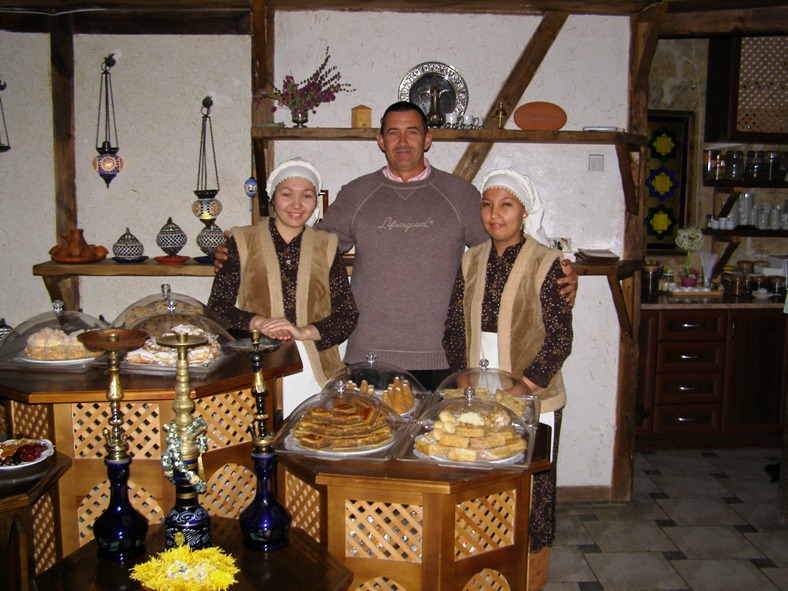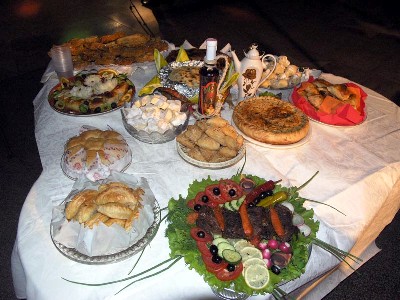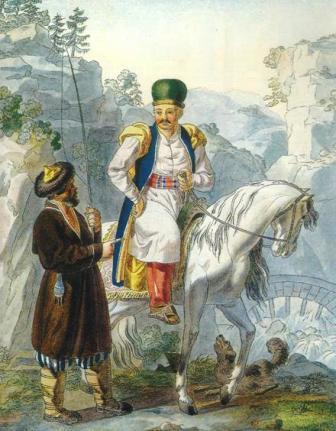We can suggest you to visit the Crimean Tatar:
-cultural centers
-cafe http://alie.com.ua/foto
-teahouse
-craft workshop
-handicraft souvenir shop.
The souvenir shop offers a wide choice of handmade works of the
Crimean Tatar masters – pile carpets and rugs, ceramics, jewelry and
embroidery.
In the cafe you can enjoy a Tatar cuisine and
watch a folklore singing and dancing.
 The Crimean Tatars are Turkic people who
inhabited the Crimean peninsula, now a part of Ukraine, for over seven
centuries. They established their own Khanate in the 1440s and remained
an important power in Eastern Europe until 1783, when Crimea was annexed
to Russia. During World War II, the entire Tatar population in Crimea
fell victims to Stalin's oppressive policies. In 1944 they were unjustly
accused of being Nazi collaborators and deported en masse to Central
Asia and other lands of the Soviet Union. Many died of disease and
malnutrition. Although a 1967 Soviet decree removed the charges against
Crimean Tatars, the Soviet government did nothing to facilitate their
resettlement in Crimea and to make reparations for lost lives and
confiscated property. Today more than 250,000 Crimean Tatars are back in
their homeland, struggling to reestablish their lives and reclaim their
national and cultural rights against many social and economic
obstacles. The Crimean Tatars are Turkic people who
inhabited the Crimean peninsula, now a part of Ukraine, for over seven
centuries. They established their own Khanate in the 1440s and remained
an important power in Eastern Europe until 1783, when Crimea was annexed
to Russia. During World War II, the entire Tatar population in Crimea
fell victims to Stalin's oppressive policies. In 1944 they were unjustly
accused of being Nazi collaborators and deported en masse to Central
Asia and other lands of the Soviet Union. Many died of disease and
malnutrition. Although a 1967 Soviet decree removed the charges against
Crimean Tatars, the Soviet government did nothing to facilitate their
resettlement in Crimea and to make reparations for lost lives and
confiscated property. Today more than 250,000 Crimean Tatars are back in
their homeland, struggling to reestablish their lives and reclaim their
national and cultural rights against many social and economic
obstacles.
The Crimean Khanate has its roots in the
dissolution of the Golden Horde, one of the successor empires to the
great Mongol empire created by Genghis Khan. Over the years, the Golden
Horde had become a mix of Mongol and Turkic peoples and the formerly
nomadic warriors had begun to create permanent settlements. In 1441,
Haci I Giray declared independence from the Golden Horde  and established
the Crimean Khanate. The Khanate came under the protection of the
Ottoman Empire, but remained a largely independent entity. Islam was the
official religion, though other religions were tolerated and the
Crimean Tatars lived peacefully with their close neighbors, the Karaim.
From the 16th until the 18th century, the Crimean Khanate was one of the
strongest powers in Eastern Europe. Much of their economy depended on
supplying cavalry troops to the Ottoman Empire (and the booty carried
home by returning troops) and raiding points north to kidnap ethnic
Slavs and sell them into slavery. The Tatars regularly invaded all the
way to Moscow and, in 1571, burned the city to the ground and enslaved
150,000 Russians. By some accounts, three million ethnic Ukrainians,
Russians and other Slavic individuals were sold into slavery during the
Crimean Khanate. Russia paid tribute to the Khanate until 1680. In the
18th century, however, as the Ottoman Empire began to decline and the
Russian Empire became stronger, the Crimean Khanate was no longer able
to exert the influence it once had. After the Russo-Turkish War of
1768-1774, Russia gained control of Crimea and formally annexed it in
1783. and established
the Crimean Khanate. The Khanate came under the protection of the
Ottoman Empire, but remained a largely independent entity. Islam was the
official religion, though other religions were tolerated and the
Crimean Tatars lived peacefully with their close neighbors, the Karaim.
From the 16th until the 18th century, the Crimean Khanate was one of the
strongest powers in Eastern Europe. Much of their economy depended on
supplying cavalry troops to the Ottoman Empire (and the booty carried
home by returning troops) and raiding points north to kidnap ethnic
Slavs and sell them into slavery. The Tatars regularly invaded all the
way to Moscow and, in 1571, burned the city to the ground and enslaved
150,000 Russians. By some accounts, three million ethnic Ukrainians,
Russians and other Slavic individuals were sold into slavery during the
Crimean Khanate. Russia paid tribute to the Khanate until 1680. In the
18th century, however, as the Ottoman Empire began to decline and the
Russian Empire became stronger, the Crimean Khanate was no longer able
to exert the influence it once had. After the Russo-Turkish War of
1768-1774, Russia gained control of Crimea and formally annexed it in
1783.
 The Crimean Tatars were persecuted under
Russian rule and, during the 19th century, it is estimated that one
million left Crimea for Turkey and other safer havens. In May 1944, more
than 190,000 Tatars were rounded up over a period of three days and
deported to central Asia, primarily to the Uzbek SSR (what is now
Uzbekistan). Stalin had accused the Tatars of collaborating with the
Nazis, who had occupied Crimea from 1941 to 1944. While some certainly
had – indeed there was an official Nazi "Tatar Legion" – many others had
fought with the Red Army. Nevertheless, all were rounded up and
deported. Many died along the way or in the deplorable conditions they
found in the Uzbek SSR. Although the charges against the Tatars were
formally lifted by the Soviet government in 1967, no efforts were made
to allow them to return. Not until after Ukrainian independence in 1991
were large numbers (some 250,000) of Tatars able to return to their
homeland in Crimea. The Crimean Tatars were persecuted under
Russian rule and, during the 19th century, it is estimated that one
million left Crimea for Turkey and other safer havens. In May 1944, more
than 190,000 Tatars were rounded up over a period of three days and
deported to central Asia, primarily to the Uzbek SSR (what is now
Uzbekistan). Stalin had accused the Tatars of collaborating with the
Nazis, who had occupied Crimea from 1941 to 1944. While some certainly
had – indeed there was an official Nazi "Tatar Legion" – many others had
fought with the Red Army. Nevertheless, all were rounded up and
deported. Many died along the way or in the deplorable conditions they
found in the Uzbek SSR. Although the charges against the Tatars were
formally lifted by the Soviet government in 1967, no efforts were made
to allow them to return. Not until after Ukrainian independence in 1991
were large numbers (some 250,000) of Tatars able to return to their
homeland in Crimea.
Bakhchisaray's
most famous attraction is the Khan Palace (Hansaray), started in 1532
by Khan Sahib I Giray when he established the city as the capital of the
Khanate. It is the only Khan palace left extant in Crimea. Visitors to
the palace today can see the Big Khan Mosque, one of the first
structures to be built in the complex, and a nearby cemetery that holds
the remains of nine khans plus other members of the royal family and
aristocracy. The former living quarters of the palace have been restored
and furnished in period pieces and other areas have been converted into
a museum to display artifacts from the period.
See also about Bakhchisaray & Khan Palace
See
also about brilliant Crimean Tatar scientist, educator and humanist Ismail
Bey Gaspirali (Gasprinsky)
http://www.iccrimea.org/gaspirali/
More
about nowdays of Crimean Tatars
http://www.iccrimea.org/index.html
| 